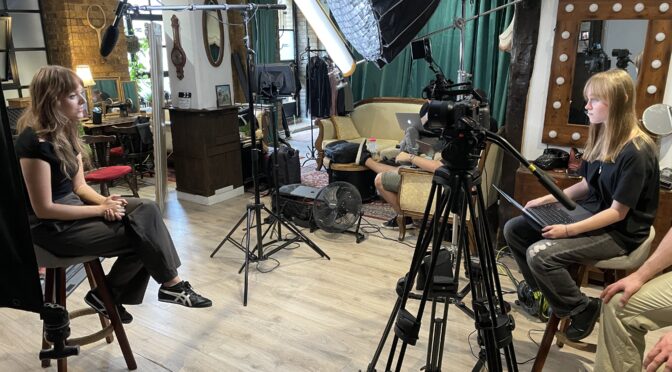Video is becoming an increasingly important asset for brands who want to get their message out there. Platforms like YouTube have made it increasingly easier to create video content, and 86% of businesses now use video marketing. But what about the other 14%? This guide offers you all the Small Films handy tips for video marketing.
What is video marketing?
Video marketing uses video to engage users and get them to make an action after watching. It forms part of digital marketing, working alongside written content or as a standalone method to build your brand. It’s popular with both b2b and b2c companies.
It was once considered a luxury for marketers due to the costs involved. But now, it’s an essential part of any marketing strategy, thanks to tech improvements that have made creating video content for audiences easier.
Video content became really accessible sometime after 2010 and coincided with the explosion of social media, the availability of online tools and faster internet speeds. Today, internet users consume an average of 16 hours of video online per week.
Why video marketing is important
Moving images have always had an advantage over other forms of content. In the 1970s and 80s, the explosion of television saw it overtake radio as the primary form of entertainment. A similar evolution happened online, with mega-fast broadband connections and 3,4 and 5G allowing consumers to stream videos online in real-time.
The ease at which people can upload and view video makes them highly watchable and just as shareable. As a result, video has become the primary way for people to use the internet, and marketers have taken note.
It’s also easier to consume – viewers retain 95% of a message when they watch it in a video compared to 10% when reading it in text. That alone makes video content even more important for brands when coming up with a marketing strategy.
Types of video marketing
Brand Films
Often created as part of larger advertising campaigns, branded videos highlight every aspect of a company. That includes its vision, mission statements, culture and products or services. Brand videos aim to build awareness and create intrigue with audiences.
A brand film the Small Films delivered for Sock Shop
Explainer videos
Explainer videos give your audience more insight into the brand offerings. It helps them understand why they should use your product or service and what they can expect. Explainer videos usually showcase how your brand works, the problems it solves and the primary benefits to users.
>> Read our blog on ‘How to write a killer explainer video script.’
Animated videos
Animated videos typically allow you to be more creative, as you can use your imagination to bring illustrations to life. They are particularly helpful for hard-to-grasp concepts, as the visual element offers the solution with an imaginative display that real-life video can’t replicate.
A Small Films video animation for Rex London
Customer testimonial videos
There’s nothing quite like real-life validation to show how well a product or service works. Using customer testimonial videos reveals how your business solves problems for real people via a short interview or statement using loyal customers. After all, your customers are your best advocates, and a testimonial video can capture their enthusiasm for your brand.
>> Check out our blog on ’11 inside tips for effective customer testimonial videos.’
How-to videos
How-to videos are more in-depth than demos, taking certain aspects of your offering and breaking them down into easily digestible content. E.g., if you offer CRM software, your how-to videos might cover each part of the service, from how to add leads to the pipeline to ways for them to store information.
Demo videos
A demo video shows potential customers how your product or service works. It takes them on a tour, detailing everything they need to know – whether it’s a physical product test or the processes of using software provided by your business.
A Small Films product video for Aldi
>> Read ‘8 tips for creating a product video that sells.’
Where can audiences find video marketing?
Viewers can see video content pretty much anywhere on the web, from your website to social media channels. Video marketing on Instagram, Facebook and Twitter is becoming increasingly popular, with brands posting it on their pages and using sponsored ads to boost their reach.
Many companies also host videos on their website, using demos and video explainers to generate interest from customers. But YouTube is by far the most popular place to watch videos online. The platform averages 500 hours of content uploaded every minute and is used for b2c content as well as b2b video marketing. Regardless of where you host videos online, you’ll need excellent content and well-shot videos to drive traffic.
How to get started with video marketing
The best way to get started involves settling on a strategy for the type of video content you want to make and a platform to showcase it. Some actions to consider for the best results include:
- Planning your video
- Writing a script
- Understanding how cameras work and your use of them
- Setting up audio
- Preparing the on-screen talent
- As well as the off-screen team
- Shooting
- Organising the footage
- Editing your video
- Choosing music
- Recording voice-overs
- Uploading to the right platform
>> See how the Small Films team can help with your video marketing strategy.
Even though it’s now much easier to make video content, anything you release still needs to look good and be high in quality. Many brands implement the use of a video marketing agency to create excellent content and boost lead generation.
Whichever route you go down, ensure that you spend time thinking about your needs and the type of video you want to release. By giving due time and care to your concept, you’ll increase the chances of making a great video, whether it’s shot in-house or by a video production company.
Final words: video marketing 101
Brands need to include video content in their marketing strategies, and it’s now an expectation that you offer your audience good-quality video content. Doing so can increase awareness, create engagement and drive sales for your brand.





